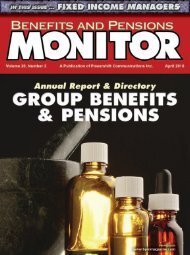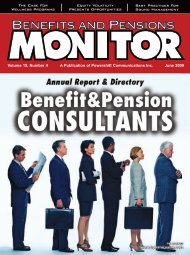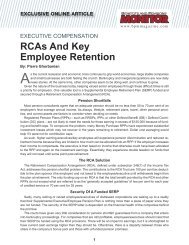BPM October 2010.indd - Benefits and Pensions Monitor
BPM October 2010.indd - Benefits and Pensions Monitor
BPM October 2010.indd - Benefits and Pensions Monitor
You also want an ePaper? Increase the reach of your titles
YUMPU automatically turns print PDFs into web optimized ePapers that Google loves.
<strong>Benefits</strong> <strong>and</strong> <strong>Pensions</strong> <strong>Monitor</strong> – <strong>October</strong> 2010<br />
2010 Annual Report & Directory<br />
Passive management refers to a simple buy<br />
<strong>and</strong> hold management strategy. In passive<br />
management, the manager creates <strong>and</strong><br />
maintains a portfolio that closely tracks a<br />
market benchmark. For our purposes that portfolio<br />
will be measured by a leading market index, the API<br />
BPI1 which is used for balanced funds along with a<br />
separate comparison using CPI, plus four per cent, a<br />
common benchmark for total<br />
fund values of a pension plan.<br />
In contrast, active investment<br />
involves a selection of<br />
securities in an asset class<br />
<strong>and</strong> more frequent buying <strong>and</strong><br />
selling of securities. An active<br />
manager seeks to build a portfolio<br />
with selective securities<br />
that are undervalued compared<br />
pooled funds beating this benchmark.<br />
However, when fees are added - 50 bps for example<br />
- we fi nd some changes taking place. The most<br />
noticeable difference is found in bonds as over a<br />
10-year period the proportion of funds above the index<br />
dropped by 45 per cent indicating that many active<br />
bond managers do not provide better than 50bps.<br />
Over a 10-year period, only 44 per cent of man-<br />
Active Versus Passive<br />
to others in the same class <strong>and</strong>, thus, earn an above<br />
average return.<br />
Market Timing Strategy<br />
Second, by employing a market timing strategy,<br />
the manager hopes to buy securities<br />
when the market is down <strong>and</strong><br />
sell securities when the<br />
market is up, as opposed to<br />
a buy <strong>and</strong> hold strategy for<br />
passive management. The<br />
argument for active management<br />
is that the fi nancial<br />
market is not effi cient in the<br />
sense that securities are not<br />
always fairly valued.<br />
Chart 1.1 illustrates<br />
the proportion of funds in<br />
a given asset class that<br />
have performed better<br />
than an index<br />
over one-, fi ve-,<br />
<strong>and</strong> 10-year compoundedperiods<br />
along with the<br />
quarter ending June 30,<br />
2010. Over 10 years, <strong>and</strong><br />
ignoring management fees, most active<br />
managers have benefi ted the investor in all<br />
asset classes.<br />
Over a 10-year period just over a quarter of<br />
balanced pooled funds beat this benchmark. There<br />
are extreme lows <strong>and</strong> highs over the fi ve- <strong>and</strong> oneoneyear periods respectively <strong>and</strong> analysis over a 15-year<br />
compounded period had 97 per cent of balanced<br />
Chart 1.1 Proportion of Funds above Index 1<br />
Balanced Bonds Canadian International US<br />
10 Years 87% 70% 91% 57% 65%<br />
5 years 56% 78% 40% 50% 44%<br />
1 Year 61% 81% 45% 58% 41%<br />
Qtr 38% 40% 30% 57% 37%<br />
Source: API Asset Performance Inc. 1 Compound Period Ending June 30, 2010<br />
agers beat the benchmarks of the index plus 25 bps.<br />
From this we can also infer that half of all bond<br />
managers reviewed earn between zero <strong>and</strong> 50bps<br />
above the index over a 10-year period.<br />
Signifi cant Decrease<br />
Based on the ability of a fund<br />
to add value to the relative<br />
asset class market index,<br />
the analysis suggests<br />
that it pays to pursue<br />
an active investment<br />
strategy over some<br />
time periods <strong>and</strong> a passive<br />
investment strategy in others.<br />
When fees are introduced, there is a signifi<br />
cant decrease in the manager’s ability to<br />
better the benchmark.<br />
Each asset class should<br />
be viewed as having a window<br />
of opportunity <strong>and</strong><br />
the plan sponsor should be<br />
cognizant of their investment<br />
manager <strong>and</strong> how<br />
they perform throughout<br />
the investment cycle. Over<br />
long periods of time, an<br />
active investor has the ability to<br />
beat an index. However, over shorter<br />
periods this becomes<br />
more diffi cult. ■<br />
Robert Dyck, CAIA, FRM, is a consulconsultant with API Asset Performance Inc.<br />
(rdyck@apiasset.com)<br />
By: Robert Dyck<br />
INSIDE<br />
2010 Annual<br />
Directory Of<br />
Money Managers<br />
Page 42<br />
2010 Statistical<br />
Report Of<br />
Money Managers<br />
Page 52<br />
For complete information<br />
from the 2010 Money<br />
Managers Report, visit<br />
www.bpmmagazine.com<br />
37









